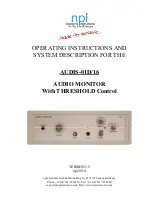
26 | en
table
3
Welding
current
(A)
Diameter of
electrode
(mm)
Welding nozzle
Flow of gas
(l/min)
n (°)
Ø (mm)
6 - 70
1.0
4/5
6/8,0
5 - 6
60 - 140
1.6
4/5/6
6.5/8.0/9.5
6 - 7
120 - 240
2.4
6/7
9.5/11.0
7 - 8
Holding the welding torch during welding:
90°
45°
position W (pa)
position h (pB)
10 – 30°
15 – 40°
position s (pF)
10
- 30°
20 - 30°
position s (pF)
Preparation of basic material:
table 4 lists the material preparation values. dimensions are determined
according to pic. 5.
picture 5
a
s
α
d
table 4
s (mm)
a (mm)
d (mm)
α (°)
0 - 3
0
0
0
3
0
0.5 (max)
0
4 - 6
1 - 1.5
1 - 2
60
Basic rules during welding by TIG method:
1.
purity - grease, oil and other impurities must be removed from the weld
during welding. it is also necessary to mind purity of additional material
and clean gloves of the welder during welding.
2.
leading additional material - oxidation must be prevented. to do so,
flashing end of additional material must be always under the protection
of gas flowing from the hose.
3.
type and diameter of tungsten electrodes - it is necessary to choose them
according to the values of the current, polarity, type of basic material and
composition of protective gas.
4.
sharpening of tungsten electrodes - sharpening the tip of the electrode
should be done in traverse/horizontal direction. the tinier the roughness
of the surface of the tip is, the calmer the burning of the el. arc is as well
as the greater durability of the electrode is.
5. the amount of protective gas - it has to be adjusted according to the type
of welding or according to the size of gas hose. after finishing the welding
gas must flow sufficiently long to protect material and tungsten electrode
against oxidation.
Typical TIG welding errors and their impact on weld quality
the welding current is too -
Low:
unstable welding arc.
High:
tungsten electrode tip breaks lead to turbulent arcing.
Further, mistakes may be caused by poor welding torch guidance and poor
addition of additive material.
Welding in methode MMA
switch the machine to mma mode - coated electrode. table 5 lists the ge
-
neral values for the choice of the electrode, depending on its diameter and
the thickness of the base material. these data are not absolute and are in
-
formative only. For exact selection, follow the instructions provided by the
manufacturer of the electrodes. the current used depends on the position
of the welding and the joint type and increases according to the thickness
and dimensions of the part.
table 5
Strength of welded material (mm)
Diameter of the Electrode
1.5 - 3
2
3 - 5
2.5
5 - 12
3.25
> 12
4
table 6: setting the welding current for the given electrode diameter
Diameter of the Electrode (mm)
Welding Current (A)
1.6
30 - 60
2
40 - 75
2.5
60 - 110
3.25
95 - 140
4
140 - 190
5
190 - 240
6
220 - 330
the approximate indication of the average current used for welding with
ordinary steel electrodes is given by the following formula:
I = 50 x (Øe – 1)
where: i = the intensity of the welding current e = the diameter of the
electrode
example for an electrode with a diameter of 4 mm:
i = 50 x (4 - 1) = 50 x 3 = 150 a
Correct electrode holding during welding
45°
β
45° +70°
picture 6
Preparation of basic material:
table 7 lists the material preparation values. specify the dimensions as
shown in pic. 7.
a
s
α
d
picture 7
table 7
s (mm)
a (mm)
d (mm)
α (°)
0 - 3
0
0
0
3 - 6
0
s/2 (max)
0
3 - 12
0 - 1.5
0 - 2
60
Summary of Contents for MAKin 250 DP
Page 32: ...32 Elektrotechnické schéma Electrical scheme ...
Page 33: ... 33 Poznámky Notes ...
Page 35: ... 35 ...











































